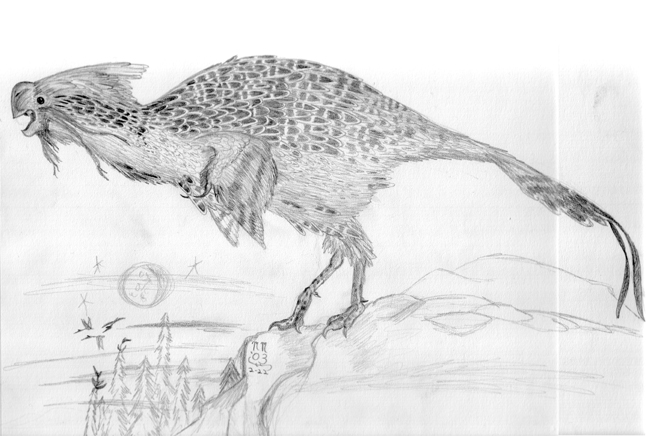home > natural history
Heyuannia huangi
"Huang's Heyuan"

One of the first dinosaurs described in 2003, Heyuannia is also the first good specimen of an oviraptorid found outside the Gobi desert, but it still retains many similarities to it's Mongolian cousins. Heyuannia huangi is most similar to the Mongolian species Heyuannia yanshini and Conchoraptor gracilis, especially in the crestless skull and short arms. Like H. yanshini and to some extent Khaan, it had a very large first finger and claw, and greatly reduced second and third digits. Heyuannia in general were also large for oviraptorids, weighing in at around 120 lbs.
I restored Heyuannia looking out over a misty evening landscape in Late Cretaceous China. Bensen-esque azhdarchid pterosaurs drift through the fog and perch atop tall conifer trees in the distance. This flightless bird is a male, sporting a speculative display of feathers around the head. I gave it degenerate wings on its small arms due to the shortness of the fingers, though more recent research suggests the short, stocky fingers of advanced oviraptorids may actually have evolved to support larger wings than their relatives. Also speculative is the Microraptor-like tail fan. Study of a pair of specimens known as "Romeo and Juliet" suggest that male and female Heyuannia had sexually dimorphic tails, with those of mails being more flexible and supported by larger muscles, probably for creating displays using the tail feathers, so we have some indication that very gaudy tail feathers must have been present. However, we don't know what the feathers were like, or if they were restricted o the tip of the tail (as in Microraptor and Caudipteryx) or extended the entire length of the tail (as in Archaeopteryx and Similicaudipteryx).
In 2015, a study Heyuannia eggs showed evidence that they were blue-green in color, and that nests were built in depressions in the ground similar to those of other oviraptorids, troodontids, and enantiornithines. Tree nesting was probably a neoavian invention.
.
Image Details:
Media: Graphite
License:
ALL RIGHTS RESERVED
DESCRIPTION
Length: 1.5m (5ft)
Weight: 10.5kg (23lbs)
Location: Zhutian Formation, China
Time: Maastrichtian age?, Late Cretaceous (~70 Ma)
CLASSIFICATION
Kingdom: Animalia
Phylum: Chordata
Class: Stem-Aves
Order: Caenagnathiformes
Family: Oviraptoridae
Genus: Heyuannia
Species: H. huangi
SYSTEMATICS
Sauropsida
Diapsida
Archosauria
Ornithosuchia
Dinosauria
Theropoda
Coelurosauria
Maniraptora
Oviraptorosauria
Oviraptoridae